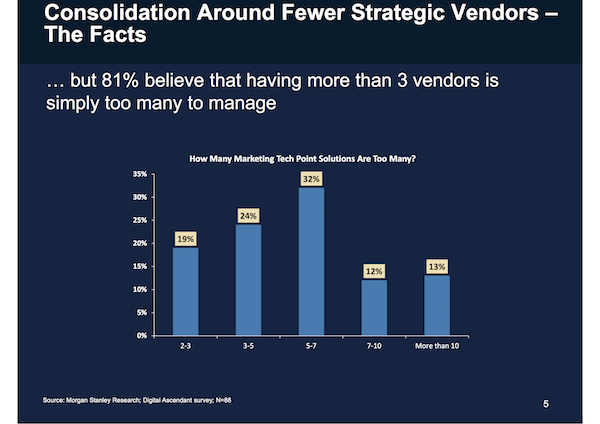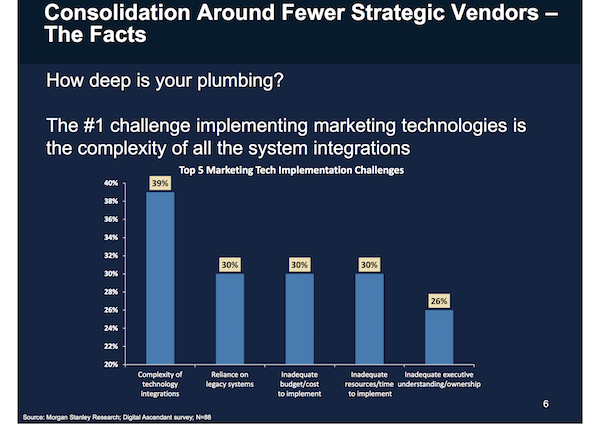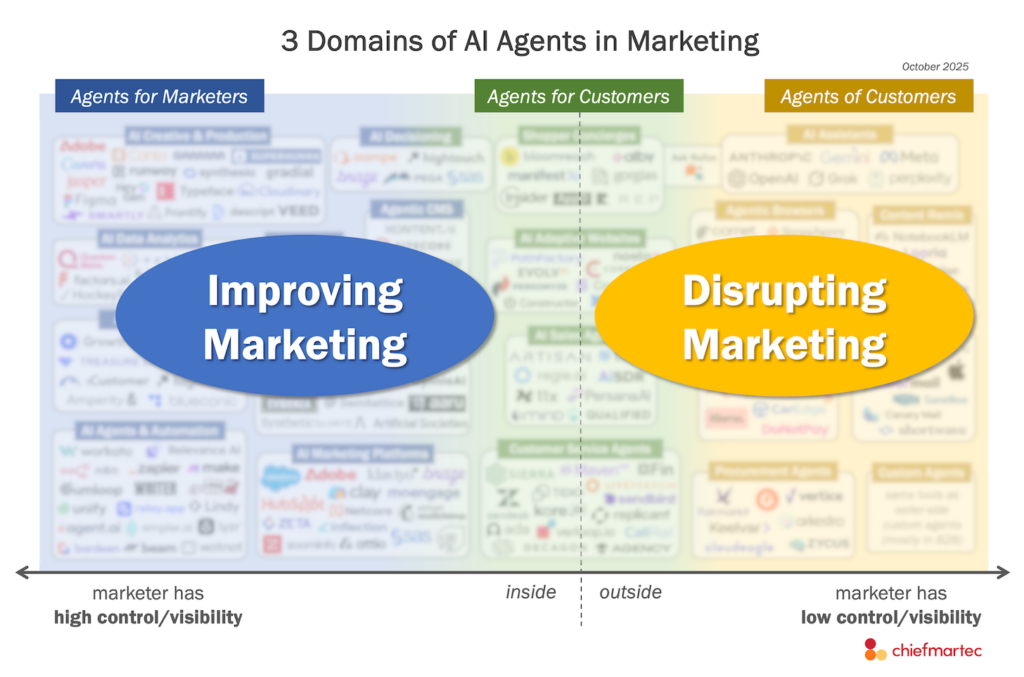A friend forwarded me a report, titled “Software Is Eating the CMO Suite,” that was shared by Morgan Stanley at the Ascendant Network event for digital marketers in New York earlier this month.
The most striking piece of data in the report, at least to me, was the chart above.
Out of the 88 participants in this survey conducted by Digital Ascendant — which I’m assuming is drawn from their network of CMOs and senior digital marketing leaders at major brands — 0% said it was critically important and only 9% said it was very important to obtain all their marketing technology from a single vendor.
In sharp contrast, 45% said it was not at all important.
Take a moment to let that sink in: top marketing leaders today are 5X more likely to think that acquiring their marketing technology from a single vendor — the grand marketing suite vision that has been promoted by a number of public companies in this sector — is “not at all important” than to think that it is “very important.”
And none think it’s “critically important.”
Granted, the remaining 46% of the participants said it was “somewhat important” — which given the much stronger wording of the other choices seems like it could be a catch-all for positions as varied as “we see pros and cons to both sides,” “we’re open to considering it,” or “we’re not sure.” I suspect some Likert-scale-like central tendency bias is at play here too.
But out of those participants who are confident — is a single-vendor approach to marketing technology important or not important, yes or no — the answer is clearly: no.
That may not come as a big surprise to regular readers of this blog, but still, that’s a powerful statement coming from one of Wall Street’s largest investment banks.
Interestingly, the very next page in their report attempts to mitigate the impact of that dramatic conclusion, although in a somewhat bizarre manner:
Morgan Stanley claims that 81% of these senior marketers believe that having more than 3 vendors is simply too many to manage. “Okay, maybe the single vendor suite is dead, but a select 2-3 strategic vendors will prevail” seems to be their narrative.
It’s a nice narrative for their “consolidation around fewer strategic vendors” thesis, but oddly the data they present as evidence doesn’t match that narrative at all.
As far as I can tell from the graph of their data, the opposite is true: only 19% of marketers think 2-3 marketing tech point solutions are too many. 81% have a higher tolerance level for more vendors.
But this graph is a little weird. For one thing, the overlapping boundaries in the categories make it hard to calculate exactly where respondents hit their limit. Next time, I’d humbly propose surveying with categories like 2-3, 4-5, 6-7, 8-10, and more than 10.
Also, aside from greater precision with quantifying the categories, I’d like to see greater precision in the definition of the terms “strategic vendor” and “point solution.” In my mind, these are not the same thing.
I’m actually a believer in the benefits of a marketing team standardizing around a relatively small number of true marketing technology platforms — systems that can serve as the foundation of common customer data and common digital assets. To me, those are the most strategic marketing technology vendor relationships that a company must manage.
But a huge benefit of true platforms is that they can be augmented by more specialized third-party capabilities — or “point solutions” if you prefer that term.
Let’s say that your “360-degree view of the customer” strategic vendor platform is a CRM, a marketing automation platform (MAP), a customer data platform (CDP), or a data management platform (DMP). I know, those are different kinds of systems, but they are the most well-known ones vying for such a 360-degree view.
Why does that 360-degree view system need to natively have the best A/B testing functionality for your website? Or the best SEO auditing? Or why does it need to be best at hosting an online community? Or running a webinar? Or managing video advertising on YouTube? Or finding key influencers on social media? Or building groovy interactive content? Or running your agile marketing Kanban board? Or dozens of other specialized tasks in modern marketing.
It doesn’t.
And it’s folly to expect that any one vendor would be the best at all of those things, not to mention all of the new innovations that we can’t even yet imagine coming in the years ahead.
Yes, with a number of these point solutions you’d want to pull some data from the 360-degree view system — or add some data to it — but in most cases, we’re talking about extremely lightweight data. We want to recognize someone we already know, and we want to note that they had a particular touchpoint with us. These are pretty simply APIs. And it’s why a true platform strategy in marketing technology is so viable.
Most of these point solutions aren’t “strategic vendors.” That’s overstating — and vastly overcomplicating — their role. They’re just great software products, mostly offered as on-demand services in the cloud.
Which brings me to one last graph from that Morgan Stanley report:
Here again, they have a narrative they want to tell — that the #1 challenge implementing marketing technology is the complexity of all the system integrations. This time, the data they share does correspond to that conclusion, but they present it with a misleading truncated graph — note that the y-axis starts at 20% instead of 0%.
The result is that it looks like “complexity of technology integrations” is nearly 2X more of a challenge than “reliance on legacy systems,” “inadequate budget/cost to implement,” and “inadequate resources/time to implement.” But in truth, the complexity of integrations was a challenge for 39% of the participants — while each of those other three difficulties were challenges for 30%.
Stating that integration complexity is only 9% more frequent of a challenge than wrangling legacy systems, inadequate budgets, and inadequate time and resources does put it in a more modest context.
My impression is that Morgan Stanley is advocating for “Big Martech” — albeit no longer as a single-vendor suite — which makes sense, as those are generally the companies that are public or soon-to-be-public. But to me, the data seems to suggest that the multi-vendor marketing technology stack is winning — and that will continue to motivate support for a more open and heterogeneous martech environment ahead.
P.S. Since someone sent me this report second-hand, I’m not able to post the full document here. However, if Morgan Stanley makes the report available on a public website, I’ll be happy to update this post with a link.






Scott you’ve got some of the best content on martech in existence. I think this is widely understood, but after stumbling around the fluffy stuff available from sales collateral and most other publications, it’s so refreshing to get something that actually informs both vendors and brands. Thanks.
Thanks, Evan! I’m happy that my ramblings resonate — even more happy if they’re helpful.
Love this post, Scott! The topic of moving to a single vendor or maintaining (and growing) our MarTech stack with multiple vendors is often debated by my team. In our research, we’ve actually found the integrations that the suite vendors try to promote either don’t really exist or are limited in what they can actually do.
Initially, I think there was a slight fear that some of the vendors would limit their integrations for competitive vendors, but given flexibility is a key criteria by most customers it would be business suicide if they chose to “build a wall”.
Thank you. I actually think the major enterprise vendors are better served by representing their products offerings as what they are: a portfolio of key — and increasingly open — systems rather than a tightly integrated suite. It takes some of the unrealistic pressure off of their expectations and lets them compete on multiple fronts.
IBM did exactly this with Universal Behavior Exchange, which leverages pre-built connections from the IBM Marketing Cloud to major platforms (even competitors). Rather than discouraging multi-vendor stacks, they made it easier (and free).
Disclaimer: I sell the IBM Marketing Cloud; before that, I was an agency marketer who used multiple platform, and have experienced a fundamentally more open approach from IMC compared to the other platforms, who would acquire great point solutions then functionally take them off the market.
I think most smart marketers will always choose the best of breed solution rather than a a combination of ordinary ones. After all, their remuneration and future depend on them producing the best result.
Picking the easy option is the path to failure.
All of the best marketers that I know have embraced a best-of-breed strategy with their marketing technology infrastructure. They rationalize their choices carefully — it’s not the random pursuit of shiny-object syndrome — but they’re not beholden to a single vendor.
Exactly
No surprise at all in this survey. Vendors believe there is advantage (sales & marketing leverage) which comes from offering a “suite”. For customers, purchasing a “marketing suite” has advantages only if a) the combined solutions truly work better than using best of breed and leveraging APIs (since most Marketing Suites have been created through acquisitions, there is little real benefit for a customer here), and/or b) the customer can get a significant discount (by buying multiple modules from one vendors, e.g., buy 4 for the price of 2).
Great post, Scott. Marketers have to make hard decisions today and, while some analysts and others are advocating marketers take a “do it all yourself” approach that results in the “Shadow IT” effect, I’ve been happy to see more interest in marketers partnering with their enterprise IT counterparts to make technology decisions that will benefit their organizations in the long run. Those decisions typically end in ‘best of breed’ solutions and generally that involves exactly what you’ve described: a core platform — a hub, so to speak – that serves both the data and channel needs and a substantial ability to add point solutions through APIs.
My 2 cents on this is that those CMO’s in the major brands already have a vast variety of technologies from the business and IT supporting their operations and digital strategy. Very few of them would be in a position to clean house and start from scratch with a single vendor cloud platform. I believe that represents the low number in ‘importance of single vendor’ question. Related to that is the ‘tolerance to a variety of vendors’ question. They live in the real world and know that while they have thoughts on moving to fewer vendors, their reality is anchored by the fact that their company will continue to have and use a variety of vendors and solutions. We had a MarTech group conversation around the ‘right number of systems’ if you recall and I would be curious how those numbers looked compared to these.
I believe the reason for this is a perception, reality or not, that cutting-edge martech is being developed by start-ups. Marketers want to leverage the latest and greatest new technology no matter who is developing it.
Hi Scott,
The headline caught my eye because there seems to be this all or nothing idea around marketing platforms which as you pointed out is really a misconception. Fundamentally Morgan Stanley asked a bad question. Hardly anyone will get all their martech from one vendor because no single vendor has everything most marketers need.
Platforms are good considerations for core functionality in a number of cases: where integrations have become complex and costly, where vendor management is out of control, for late adopters that don’t have the expertise to run many different environments, for consultancies (and *wince* agencies) to build out their marketing as a service offerings.
It will be interesting to see how this plays out in the next few years as platforms mature and expand.
Hi Scott, Nice post! I think the thing most people miss (and this doesn’t mention it either) is what matters is not that a company has 1, 2 or X vendors for their marketing tech (other than the proverbial “one hand to shake or neck to choke” – depending on your disposition that day)…but instead that the end user can get their job done effectively with the tool set they use.
As orgs get bigger, invariably jobs get more specialized, so I would argue that so long as the different tools work together effectively – which is not common place amoung different vendors, then having a mix of vendors is fine (especially closely adjacent ones to a particular type of worker/work). What is frustrating to a user is when they have to learn 15 interfaces, and try to move data between systems to do analysis, testing and program execution. Best
@vjeffs
Hi Scott, Now you are talking my language-plumbing! As you have noted, the biggest challenge for marketers today is finding a vendor/integrator who can break down business unit and marketing team silos by creating an open standards centralized marketing data and asset repository that can feed core marketing data to all downstream channels.
We have been doing that at Stibo Systems with our PIM and MDM solutions which offer easy connectivity through various API’s and or data feeds. We call ourselves “functional plumbers” and have been helping some of the largest companies around the globe do this for over 30 years. We provide a single source foundation layer to build a Content Ecosystem.
From Avinash Kaushik himself – most firms don’t even use the upgraded free + premium Google Analytics tools to it’s full potential and most companies have no idea how to use all these analytics, optimisers, etc software so agree with Morgan Stanley’s conclusion though you are right about the clarity of their analysis.